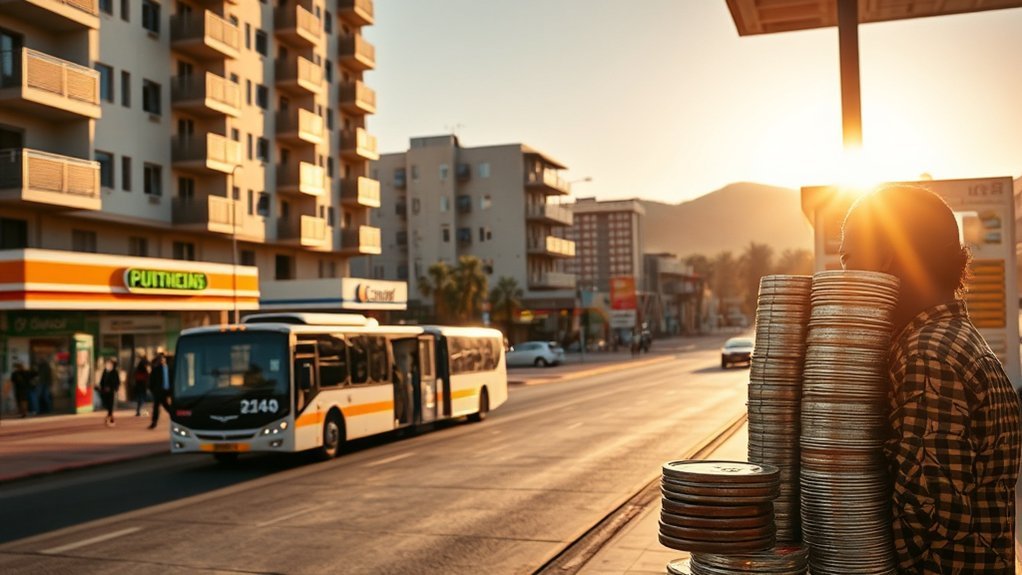You’ll typically need about USD 800–1,300 monthly for a modest two- to three-bedroom rental in urban Namibia, with housing dominating budgets. Groceries and dining are generally cheaper than in many Western countries, utilities run lower than U.S. averages, but fuel and mobile data can add up. Expect private healthcare and international schools to cost considerably more. Taxes and banking fees affect take-home pay. Keep going to see detailed breakdowns for each cost category.
Cost of Housing and Rentals in Namibia
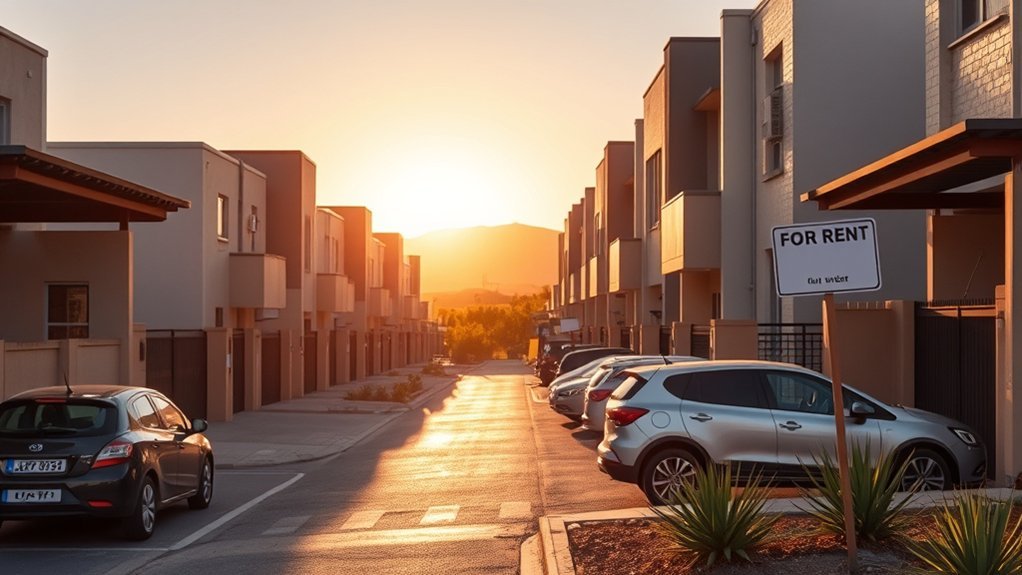
Housing is the single largest expense you’ll face in Namibia: two- to three-bedroom apartments typically rent for USD 806–1,300 per month, and family units in safe urban neighborhoods can exceed N$12,000 (about USD 630) monthly.
You’ll find rentals sharply segmented: higher-income residents cluster near Windhoek, pushing demand and rents up, while mid- and lower-income households often settle in suburbs like Katutura where prices are lower.
For buyers, a two-bedroom house can list around USD 320,000 versus a two-bedroom apartment near USD 64,000, illustrating a wide price differential between property types.
The Cost of Living impact is clear: housing dominates budgets and accounts for most household spending variance across income groups.
Ongoing debates about rising apartment prices trace to persistent high demand and constrained urban supply, which keep rental yields elevated.
When you plan relocation or budgeting, prioritize housing costs first, then adjust other Cost of Living elements around the chosen neighborhood and tenure.
Groceries, Dining Out and Everyday Essentials
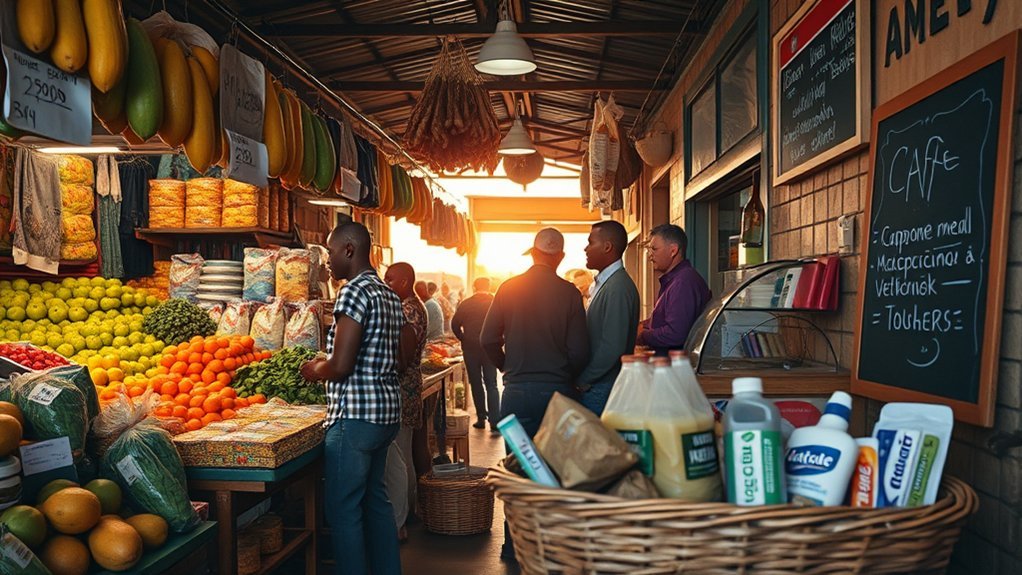
On a day-to-day basis you’ll find Namibia’s grocery and dining prices generally lower than in many Western countries: a liter of UHT milk or a bottle of water runs about 15 N$ each, fresh chicken is around 60 N$/kg (frozen about 45 N$/kg), while a typical lunch menu averages roughly $9.53—about half the U.S. cost—and a restaurant dinner for two is ~$35.90 versus $78.20 in the U.S., making food expenses and everyday essentials comparatively affordable for most expatriates and local middle-income households.
You can stretch a modest groceries budget by buying local produce and frozen proteins. Fast-food equivalents cost roughly $5.19 versus $11.20 in the U.S., so casual meals remain economical. Below is a concise price comparison to guide planning.
| Item | Namibia (N$) | U.S. (USD equivalent) |
|---|---|---|
| UHT milk / water (1L/bottle) | 15 | ≈ $0.86 |
| Fresh chicken (per kg) | 60 | ≈ $3.45 |
| Frozen chicken (per kg) | 45 | ≈ $2.59 |
| Lunch menu (avg) | — | $9.53 |
Utilities, Internet and Communication Expenses
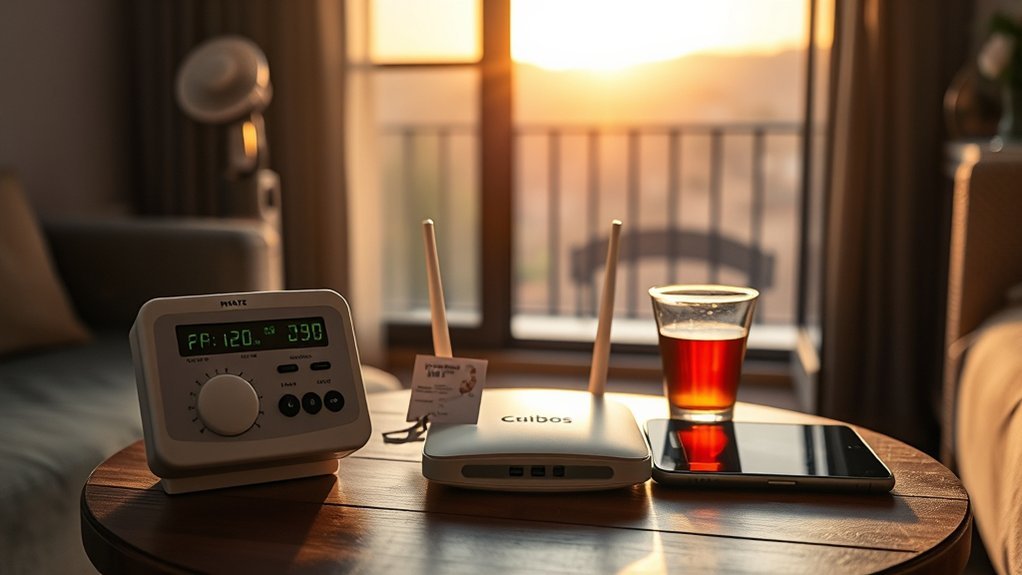
You’ll find basic utility bills in Namibia average about $66.40 per month, noticeably lower than the U.S. average of $124, with prepaid electricity costing ~2.48 N$/kWh versus around 2.30 N$/kWh for post-paid. Internet unlimited plans at 50+ Mbps run roughly $53.30 monthly—cheaper than the U.S.—but 3G data can exceed 1 N$/MB out-of-bundle, so mobile use can get costly.
Rural water and sanitation are often cheaper than urban, which can further reduce your overall monthly expenses.
Electricity and Water Costs
How much will utilities bite into your budget in Namibia?
You’ll pay about 2.48 N$/kWh if you use prepaid electricity and roughly 2.30 N$/kWh with post-paid — a meaningful per-kWh difference that affects monthly totals.
Average utility bills (electricity, heating, water, other services) run near $66.40 per month, which is competitive regionally.
Water costs vary: rural rates are generally lower than urban, so living outside cities reduces your water bill and overall expenses.
Note that unreliable service can inflate costs: many households spend up to 1,200 NAD monthly on extra data or backup measures tied to outages.
Compared to U.S. levels, typical bundled utilities here are modest, but your choice of prepaid versus post-paid and location will drive final costs.
Internet, Mobile and Data
Beyond basic utilities, your internet and mobile bills quickly shape monthly costs — especially where power or service is unreliable. Internet in Namibia averages $53.3/month for a 50 Mbps unlimited plan, below the U.S. $66.5 average, but reliability issues raise true cost for remote work. Mobile and data top-ups can exceed N$1,200/month when you need extra bandwidth, reflecting business reliance on connectivity. Basic utilities average $66.4/month versus $124 in the U.S., so communication is a larger slice of your budget.
| Service | Typical monthly cost |
|---|---|
| Internet (50 Mbps unlimited) | $53.3 |
| Mobile/data extras | > N$1,200 (~$74) |
Transportation and Fuel Costs
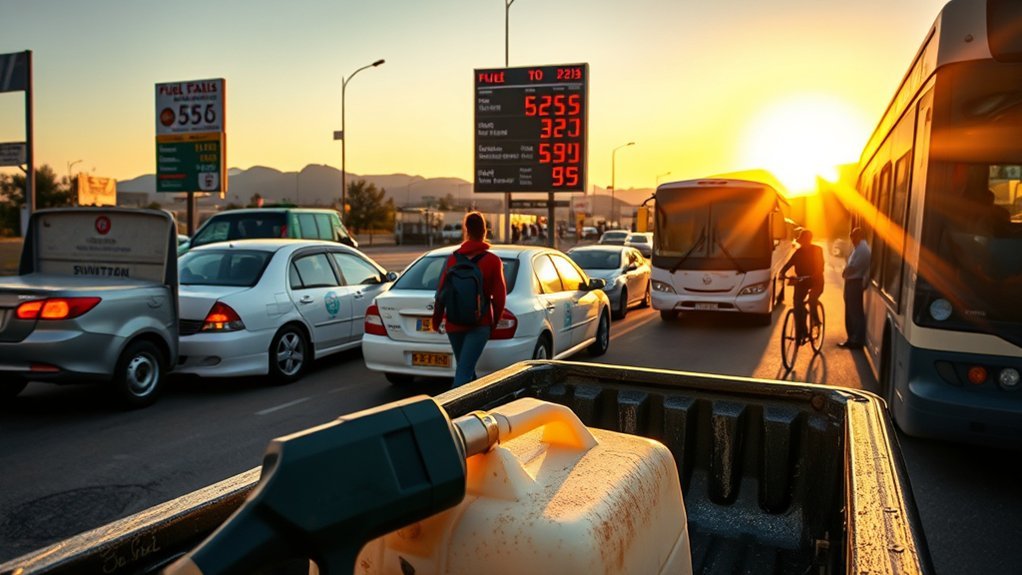
You’ll notice fuel averages about 20–21 N$ per liter, a key driver of rising monthly transport expenses compared with regional neighbors.
Public options—minibuses at ~10 N$, taxis around 12 N$ (or ~$7.16 for an 8 km trip) and a monthly pass near $36.90—remain cheaper than owning a car when you compare routine commute costs.
But if you rely on a personal vehicle, expect maintenance, insurance and fuel to push monthly totals toward 3,000 Nam$, shifting the cost-benefit toward public transport for regular commuters.
Fuel Price Trends
Although Namibia relies heavily on imported fuel, current prices—about N$20–21 per liter for gasoline and roughly N$8 per liter for LPG—keep household and transport budgets tightly linked to global oil movements.
When living in Namibia, you’ll notice gasoline costs make personal vehicle use a major monthly line item; active drivers can see transport bills approach N$3,000. LPG’s lower N$8 rate offers a cost-effective alternative for cooking and heating, reducing domestic energy pressure.
Compared regionally, fuel remains moderate but volatile, so small international shifts change local costs quickly. Short urban trips often favor taxis (≈$7.16 for 8 km) over more expensive private usage.
You should budget fuel as a variable expense and monitor international oil trends to anticipate price swings.
Public Transport Fares
Because public transport stays far cheaper than taxis or private cars, you’ll save by relying on buses and minibuses when they’re available: a single local ticket runs about $0.74 and a monthly pass about $36.90, while minibuses charge roughly N$10 per trip and an 8 km taxi ride costs about $7.16.
Public transport fares are clearly the low-cost baseline: a commuter using daily single tickets spends far less than one using taxis. Minibuses at N$10 suit short, frequent trips; monthly passes make sense if routes match your commute.
Note that reliability and limited coverage push many toward personal cars despite higher costs. Budget-conscious residents should compare monthly pass value to actual route use before committing.
Vehicle Maintenance Costs
When you factor in routine servicing (N$1,000–2,500) and regular oil changes (about N$700), owning a car in Namibia quickly adds fixed maintenance costs that sit alongside fuel at roughly N$20–21 per liter. You’ll compare predictable items (service, oil, insurance) with variable ones (tyres, fuel consumption). Vehicle maintenance costs in Namibia typically average monthly to a few hundred N$ if you amortize annual insurance (N$2,000–6,000) and occasional tyres (N$1,500–3,000 each). Use this snapshot to budget realistically.
| Item | Typical cost (N$) |
|---|---|
| Routine service | 1,000–2,500 |
| Oil change | ~700 |
| Tyre (each) | 1,500–3,000 |
| Annual insurance | 2,000–6,000 |
Banking, Taxes and Financial Services
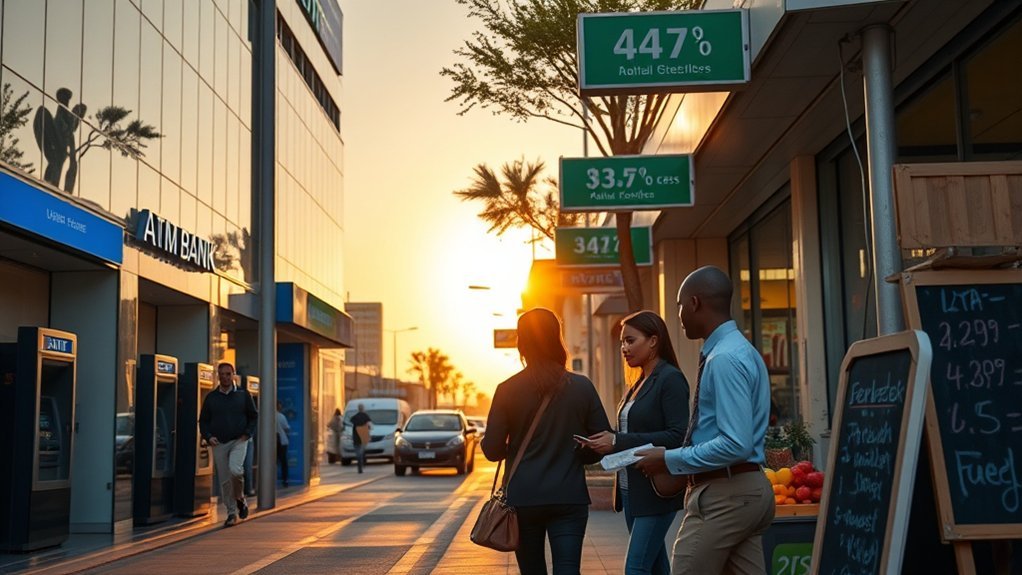
If you’re comparing financial systems, Namibia’s banking sector is tightly regulated by the Bank of Namibia, which manages the money supply and currency to maintain stability while commercial banks like Bank Windhoek, FNB, Nedbank and Standard Bank offer modern online and mobile services.
Note that interest on savings faces a 10% withholding tax on interest, every authorized-bank debit incurs a N$0.20 government duty, and personal income tax rates can reach 37%, all of which should factor into your cash-flow and investment planning.
You’ll find banking fees generally transparent, with digital channels reducing branch costs. Compare account fees, ATM networks and foreign transfer charges across providers — pricing can differ materially.
The 10% withholding tax lowers net returns on deposit instruments, so adjust yield assumptions. The N$0.20-per-debit duty is small per item but compounds if you make frequent low-value transfers.
High marginal income tax rates mean you should model after-tax investment returns and optimize tax-efficient vehicles where available.
Working Conditions, Salaries and Work Permits

Having outlined how banking costs and taxes affect your cash flow, it’s equally important to understand workplace realities and permit rules that determine whether you can earn here at all.
Namibia’s working conditions are shaped by a high unemployment rate (≈36.9%) and policies that reserve semi-skilled and unskilled roles for locals, so you’ll commonly find opportunities limited to skilled sectors.
High unemployment (~36.9%) and local-first policies mean most openings favour skilled professionals over semi-skilled or unskilled workers.
You must obtain work permits — even volunteers need them — and the application process is often lengthy and complex, so plan timelines accordingly.
Salaries are paid in Namibian dollars and face progressive income tax up to 37%, so gross pay can differ substantially from take-home pay.
Exchange control limits on remittances also affect your ability to send earnings home, influencing compensation negotiations.
Finally, breaches of residence or permit terms carry fines or imprisonment, so you should strictly comply with conditions.
Compare offers on permit sponsorship, net pay after tax, and remittance flexibility before committing to a job in Namibia.
Education, Healthcare and Expat Services
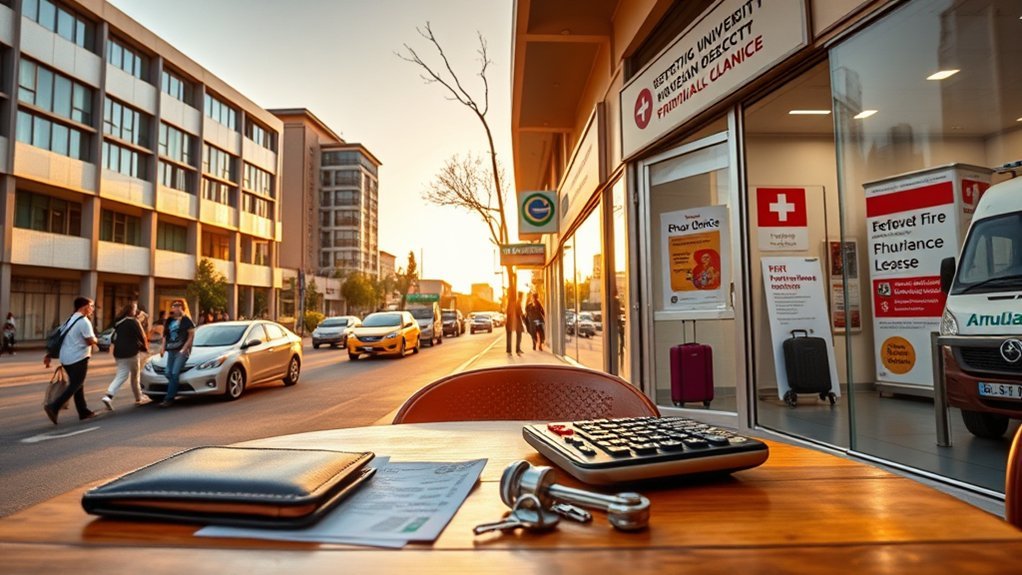
Although public schools are nominally free, you’ll usually face additional costs for uniforms and supplies, while private school fees run roughly N$20,000–N$80,000 per year and international schools for expat children typically cost N$100,000+ annually.
Education in Namibia consequently ranges from low-cost public options to premium international curricula; English is widely used, easing change compared with countries where language is a barrier.
Healthcare combines free public services for citizens and variable private care; as an expat you’ll likely buy insurance that can often exceed about N$6,000 annually to access faster, higher-quality private treatment.
Expat services help with relocation, permits and settling in; expect agency fees of roughly N$2,000–N$10,000 depending on complexity.
When budgeting, compare public versus private schooling, add potential international school premiums if you need continuity with foreign systems, factor N$6,000+ for basic expat health coverage, and allocate funds for relocation assistance if you want hands-on support managing local laws and logistics.
Frequently Asked Questions
Can US Citizens Live in Namibia?
Yes — you can live in Namibia, but you’ll need a work permit for employment; competition’s high with a 36.9% unemployment rate, taxes can reach 37%, and remittance limits mean careful financial planning.
Can a Foreigner Live in Namibia?
Yes — you can live in Namibia, but while opportunities exist, you’ll face strict work-permit rules, high unemployment (36.9%), income tax up to 37%, limited remittances, and legal risks if you breach residency conditions.
Is Namibia a Good Place to Live?
Yes — Namibia can be a good place to live if you value safety, natural beauty and lower rural costs; you’ll face high unemployment, pricey urban housing, occasional unreliable utilities, and varying food affordability compared with regional peers.
What Is a Good Salary in Namibia per Month?
Think of 15,000 NAD as a benchmark: you’d want roughly 12,000–20,000 NAD monthly. That compares to lower national averages, reflects skilled-worker pay, and nets less after taxes and high urban housing costs.
Conclusion
You’re looking at Namibia like it’s a spreadsheet with sand—rent eats a bigger cell in Windhoek than in Swakopmund, groceries are a steady column, and utilities spike when the meter decides. Compare salaries: public sector lags, mining pays, expat packages cushion. Transport costs climb with distance; schooling and private healthcare add bold lines. Don’t forget permits, taxes and bank fees padding the totals. Tally your priorities, then choose which numbers you’ll live with.

